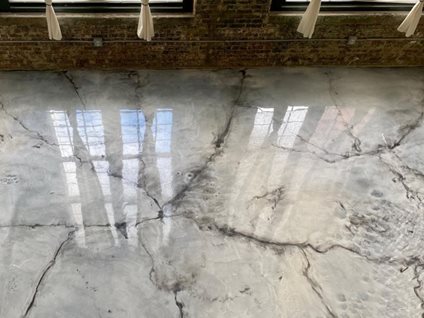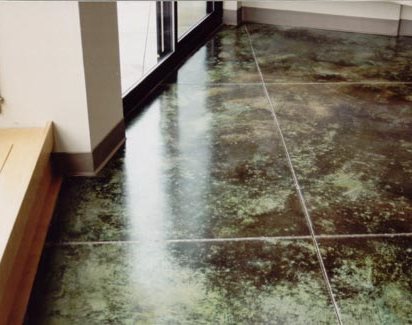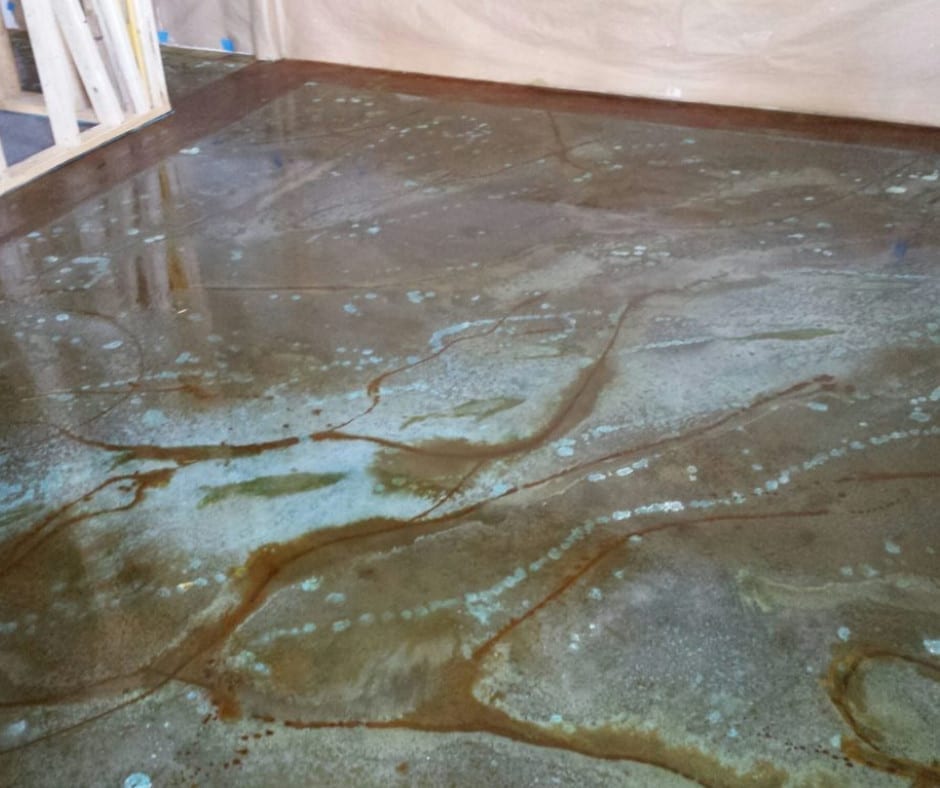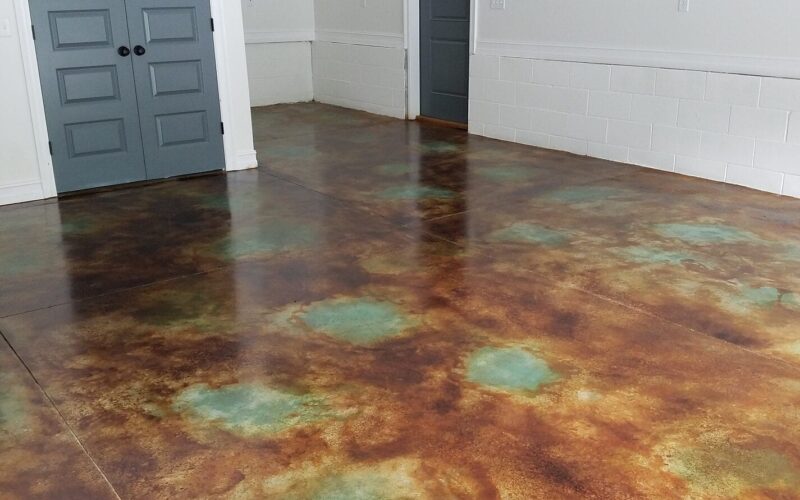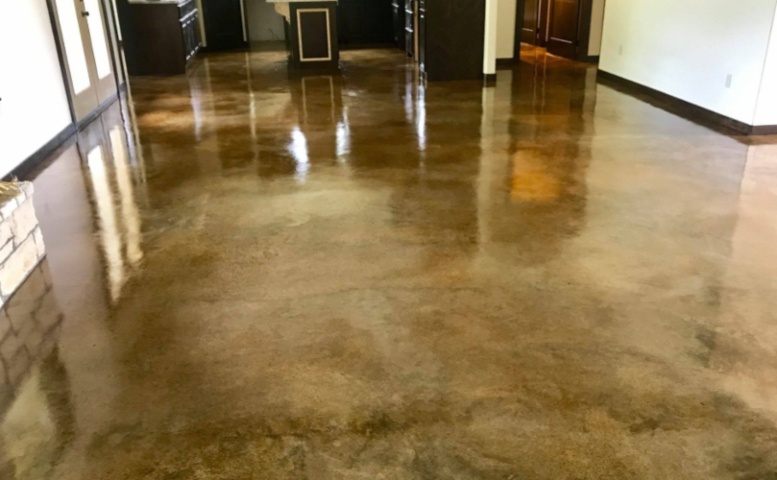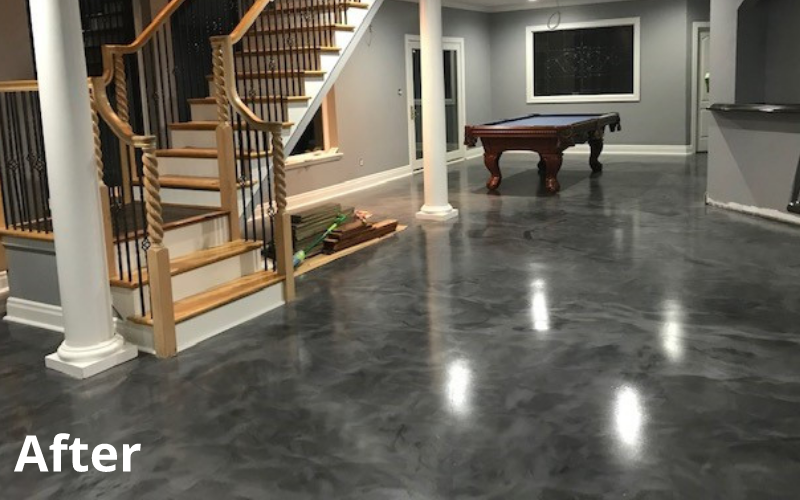As a design enthusiast with a limited budget, I always strive to find creative and cost-effective ways to elevate the aesthetics of my living space. One of the most impressive discoveries in my journey was the possibility of transforming plain concrete floors into stunning marble-like surfaces. Concrete floors that look like marble offer a luxurious and elegant appearance without breaking the bank. I’ll share my knowledge and experience on how to achieve this fantastic marble effect on concrete floors, allowing you to enjoy the beauty of marble without the high price tag.
Understanding Concrete Staining Techniques
Concrete staining is the magic behind transforming a dull concrete floor into a marble-like masterpiece. There are two primary types of concrete staining techniques: acid-based stains and water-based stains. Acid-based stains create a mottled, variegated effect on the concrete, resembling the natural veining and color variation found in marble. Water-based stains, on the other hand, provide a more consistent and controlled color application, offering a modern and refined marble appearance. Both options have their unique characteristics, so it’s essential to choose the staining technique that best suits your desired marble look.
Preparing the Concrete Surface
Achieving a marble-like finish on concrete floors requires meticulous preparation to ensure the stain adheres correctly and results in a smooth, flawless look. Start by thoroughly cleaning the concrete surface to remove any dirt, dust, or debris. You may need to use a mild detergent and scrub brush to get rid of stubborn stains or grime. If the concrete has any existing coatings or sealers, these must be removed entirely through grinding or chemical stripping to allow the stain to penetrate effectively. It’s also crucial to repair any cracks or imperfections in the concrete before staining.
Selecting the Right Stain Colors
Choosing the right stain colors is a pivotal step in creating a convincing marble effect. Marble comes in a wide array of colors and patterns, so it’s essential to select stains that mimic the specific marble you’re trying to replicate. For a classic white marble appearance, opt for light gray and white stains. If you’re aiming for a luxurious black marble effect, go for charcoal and deep gray stains. Experimenting with different stain combinations on a test area can help you achieve the perfect mix of colors and veining patterns.
Applying the Stains
Once the surface is prepared and the stain colors are selected, it’s time to apply the stains to the concrete floor. Work in small sections to ensure even coverage and control over the veining pattern. For acid-based stains, apply the stain using a sprayer or brush, allowing it to react with the concrete’s minerals to create the desired marbling effect. For water-based stains, use a brush or roller to apply the color in smooth, consistent strokes. Depending on the intensity of the color and the level of veining you desire, you may need to apply multiple coats of stain, allowing each layer to dry before adding the next.
Sealing and Finishing
Once you’re satisfied with the marble-like effect on your concrete floor, it’s crucial to seal the surface to protect the stain and enhance its longevity. Choose a high-quality concrete sealer suitable for the stained finish and apply it evenly across the floor. Sealers come in various finishes, including matte, satin, and glossy. Select the finish that best complements your desired marble look. The sealer not only protects the floor but also adds depth and richness to the stain, giving it an even more luxurious appearance.

Metallic Marble Epoxy Floor – Metallic Floors Installed Nationwide
How to Make Concrete Look Like Marble Floors – Concrete Network
Pin on Floors I Love
Residential Flooring – Elite Crete Systems Painted concrete
How to Make Concrete Look Like Marble Floors – Concrete Network
Metallic Marble Epoxy Floor – Metallic Floors Installed Nationwide
Marble Flooring for the Masses The Concrete Protector
How to Make Concrete Acid Stain Look Marbleized Direct Colors
How Much Does it Cost to Stain Concrete Floors Yourself?
MARBLELIFE® BASEMENT
Related Posts:
- White Concrete Floor Tiles
- Acid Wash Concrete Floor Colors
- Concrete Floor Thickness For A Garage
- Concrete Floor For Bathroom
- Interior Concrete Floor Ideas
- Kitchen Stained Concrete Floors
- Concrete Floor Tile Thickness
- How To Stain Concrete Floors DIY
- DIY Concrete Floor Grinding
- Concrete Floor Damage
Concrete Floors Look Like Marble
Are you looking for a unique and stylish flooring option that will give your home a luxurious feel? If so, concrete floors that look like marble may be the perfect solution. Concrete floors are not only highly durable and easy to maintain but they can also be designed to mimic the look of marble, creating an elegant and sophisticated atmosphere in any space. In this comprehensive guide, we will explore everything you need to know about concrete floors that look like marble, from the benefits and drawbacks of this option to how to choose the right color and design for your home.
What Are Concrete Floors That Look Like Marble?
Concrete floors that look like marble are created by using specialized techniques such as stamping, scoring, staining, and engraving. This allows for the creation of intricate designs that mimic the luxurious look of marble. The concrete is treated with a special sealer that gives it a glossy finish, further enhancing the marble-like appearance.
Benefits of Concrete Floors That Look Like Marble
Concrete floors that look like marble offer many advantages compared to traditional marble flooring. Here are some of the key benefits:
Durability: Concrete is one of the most durable flooring materials available, making it ideal for high-traffic areas such as entryways and hallways. Unlike marble, concrete does not require regular sealing or polishing to maintain its appearance.
Cost-Effective: Concrete floors are significantly less expensive than marble floors, making them an affordable option for those on a budget.
Low Maintenance: Concrete floors are easy to clean and maintain. All you need to do is sweep or vacuum regularly and mop occasionally with a mild detergent.
Versatility: Concrete floors can be customized with different colors, patterns, and textures to create a unique and stylish look. This allows you to create a design that complements your home’s existing décor.
Drawbacks of Concrete Floors That Look Like Marble
Although concrete floors offer many advantages, some drawbacks should be considered before making a decision:
Installation Cost: Installing concrete floors can be more expensive than other flooring options due to the specialized techniques required. Additionally, concrete must be properly sealed and maintained to preserve its beauty and durability.
Cold Temperatures: Concrete can become cold in winter months or rooms without proper insulation, making it uncomfortable for bare feet or sitting for long periods.
Noise: Concrete is not as soundproof as other flooring materials such as carpet or hardwood, so it may not be suitable for spaces where noise needs to be kept at a minimum.
How to Choose the Right Color and Design for Your Home
Choosing the right color and design for your concrete floors can be overwhelming due to the many options available. Here are some tips to help you narrow down your choices:
Consider the Room’s Décor: When selecting a color and design for your concrete floor, consider the room’s existing décor as well as any future changes you may make. Choose a color palette that will coordinate with your furniture, walls, and other accents in the room.
Mix & Match Colors & Patterns: Don’t be afraid to experiment with different colors and patterns when creating your concrete floor design. Mixing different hues can add depth and visual interest to your space while creating a more unified look.
Create Balance & Harmony: When selecting colors and patterns for your concrete floor, try to create balance by using similar tones throughout the room except in one area where you use a bolder pattern or color to draw attention. This will give the room a sense of unity while still allowing you to incorporate some uniqueness in one area.

